# Amazon Sumerian Hosts
For a general introduction to Amazon Sumerian Hosts as well as other example implementations of utilizing the core package, refer to the [primary repository](https://github.com/aws-samples/amazon-sumerian-hosts)
Amazon Sumerian Hosts is an experimental open source project that aims to make it easy to create interactive animated 3D characters that can be rendered on the Web and leverage AWS Services such as [Amazon Polly](https://aws.amazon.com/polly/). This example package includes everything you need to get started with Amazon Sumerian Hosts utilizing [three.js](https://threejs.org/).
See the [Getting Started](#Getting-Started) guide for a walkthrough using this method and the [API Documentation](https://aws-samples.github.io/amazon-sumerian-hosts/) for more detailed information on the classes and methods available. Amazon Sumerian Hosts is a published [npm](https://www.npmjs.com/) package, so alternatively you can install in an existing Node.js project by running `npm install --save-dev @amazon-sumerian-hosts/three`. If you'd like to pull the gitub repository and create your own build, see [Building the Repository](https://github.com/aws-samples/amazon-sumerian-hosts/blob/mainline2.0/README.md#building-the-repository) for prerequisites and instructions on how to do that.
## License
This library is licensed under the MIT-0 License. See the [LICENSE](LICENSE) file. The assets within examples are licensed under the CC-BY-4.0 License. See the [LICENSE](examples/assets/LICENSE) file.
# [Getting Started](#Getting-Started)
This guide steps you through the code of the [examples/three.html](examples/three.html) file, a working example demonstrating the features, such as animation and speaking user-entered text, of the Sumerian Host characters running in three.js.
## [Prerequisites](#Prerequisites)
Before you can run the example, you will need to set up a few thing in your AWS account. For step-by-step instructions on setting up this required infrastructure, see [AWS-Infrastructure-Setup.md](https://github.com/aws-samples/amazon-sumerian-hosts/tree/mainline2.0/AWS-Infrastructure-Setup.md) in the root of this repository.
## [Getting started in three.js](#Getting-started-in-three.js)
Note, most of steps below have already been completed for you. They are provided here in order to explain the code in detail.
⚠️ **Important:** There is one edit you will need to make before running the example. You will need to update the code as described in [Step 5. Configuring the AWS SDK](#step5) so that it reflects the Cognito Identity Pool ID you created during your AWS infrastructure set up (above).
### Step 1. Adding Script Dependencies
Here we will take a look at the scripts necessary for the example code to function:
- ```html
```
The hosts will need to connect to Amazon Polly to convert text into audio assets. `https://sdk.amazonaws.com/js/aws-sdk-2.645.0.min.js` is a minified build of the AWS SDK for Javascript. For the latest version, see the [AWS SDK for JavaScript API Reference](https://docs.aws.amazon.com/AWSJavaScriptSDK/latest/).
- ```html
```
* Note the version after the `@` should be the same as found in the [packages.json](package.json)
This will be the core three.js build, and is required to setup a new three.js scene. Make sure to always include this file early as it is a dependency for the GLTFLoader and OrbitControls scripts.
- ```html
```
host.three.js is the build file of the Amazon Sumerian Hosts repository that is specific to the three.js rendering engine. It must be included after the three.min.js build file. This will make a module called `HOST` available to any scripts included after this.
Now we'll move on to the body of the html file.
### Step 2. Add a loading screen
Our example is going to load several glTF assets so there will be a short time where there is no host visible in the scene. We will add a [div tag](https://developer.mozilla.org/en-US/docs/Web/API/HTMLDivElement) styled with an image and a loading spinner to show while the assets are being loaded.
- ```html
```
The outer div with id "loadScreen" is styled with a background image that fills the screen.
- ```css
#loadScreen {
display: flex;
align-items: center;
justify-content: center;
width: 100%;
height: 100%;
background-image: url('assets/images/load_screen.png');
background-color: gray;
background-repeat: no-repeat;
background-attachment: fixed;
background-position: center;
background-size: contain;
z-index: 9999;
}
```
The inner div with id "loader" is styled with a spin animation that continuously rotates the spinner.
- ```css
#loader {
border: 16px solid #3498db38;
border-radius: 50%;
border-top: 16px solid #3498db;
width: 120px;
height: 120px;
-webkit-animation: spin 2s linear infinite;
animation: spin 2s linear infinite;
position: fixed;
}
@-webkit-keyframes spin {
0% {
-webkit-transform: rotate(0deg);
}
100% {
-webkit-transform: rotate(360deg);
}
}
@keyframes spin {
0% {
transform: rotate(0deg);
}
100% {
transform: rotate(360deg);
}
}
```
The result should look like this:
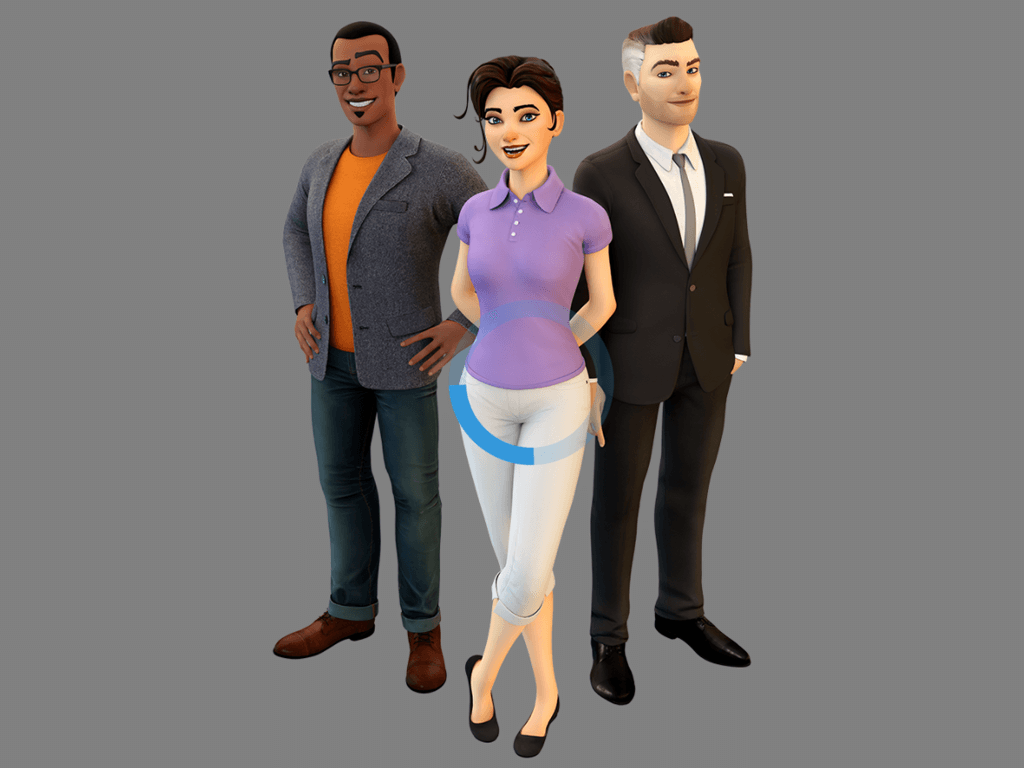
### Step 3. Create the text to speech controls
Our hosts will need some text input so we can tell them what to say, as well as some controls to play/pause/resume/stop the speech and execute emote animations. Take note of the id of each element, we'll be using these later. Note the use of the `` ssml tag. Use of this tag results in a more natural speaking style in the speech audio, but may not be available in all languages and voices. Check the [Amazon Polly Feature and Region Compatibility](https://docs.aws.amazon.com/polly/latest/dg/NTTS-main.html#ntts-regions).
```html
```
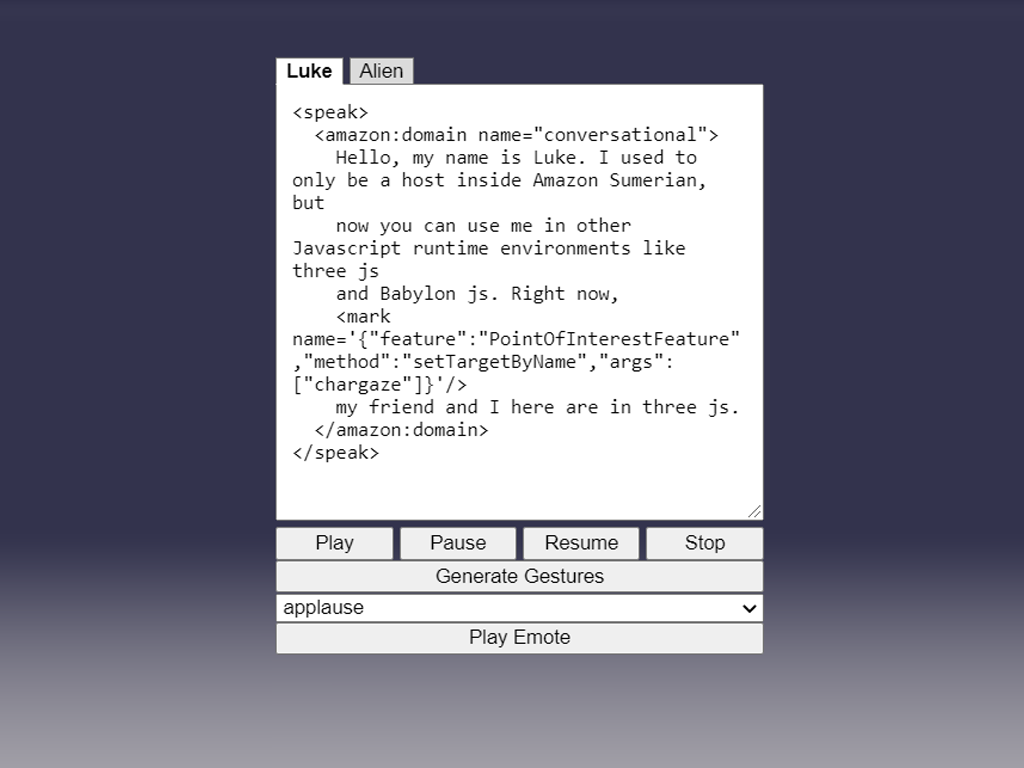
Now we will move onto the contents of the example [script](https://developer.mozilla.org/en-US/docs/Web/API/HTMLScriptElement) tag.
### Step 4. Initialize global variables
three.js requires the user to manage the render loop. We'll define an array that will be used to collect functions that need to be executed during the render loop. In addition, we'll need a way to connect our UX elements to our host objects after they've been created, so we'll keep track of those here. Take note of the names, these match up with the names of the tab UX we created earlier. This is how we'll determine which host will respond when interacting with the UX elements. Next we'll take a look inside the function called `main`. This is where we'll set up our hosts and connect them to the UX.
```javascript
const renderFn = [];
const speakers = new Map([
['Luke', undefined],
['Alien', undefined],
]);
```
### [Step 5. Configuring the AWS SDK](#step5)
Our host will be using the [TextToSpeechFeature](https://aws-samples.github.io/amazon-sumerian-hosts/three.js_TextToSpeechFeature.html), so before we can make the host speak we need to configure the AWS SDK with our region and credentials.
```javascript
// Initialize AWS and create Polly service objects
window.AWS.config.region = 'us-west-2';
window.AWS.config.credentials = new AWS.CognitoIdentityCredentials({
IdentityPoolId: '',
});
```
Replace `` with the id you created in the [Prerequisites](#Prerequisites) section. Make sure to set the region to the one you created your Cognito Identity Pool in. Using CognitoIdentityCredentials is just one example of how you can authenticate your host to access Polly. See the [AWS SDK documentation](https://docs.aws.amazon.com/AWSJavaScriptSDK/latest/AWS/Credentials.html) to see other credentials classes you can use.
### Step 6. Initializing the Host TextToSpeechFeature
The [TextToSpeechFeature](https://aws-samples.github.io/amazon-sumerian-hosts/three.js_TextToSpeechFeature.html) is the host feature that communicates with Amazon Polly to generate speech audio and speechmarks and plays them back at runtime. Before this feature can be used, it must be initialized with Polly and PollyPresigner instances, as well as the version of the AWS SDK being used.
```javascript
const polly = new AWS.Polly();
const presigner = new AWS.Polly.Presigner();
const speechInit = HOST.aws.TextToSpeechFeature.initializeService(
polly,
presigner,
window.AWS.VERSION
);
```
[`HOST.aws.TextToSpeechFeature.initializeService`](https://aws-samples.github.io/amazon-sumerian-hosts/AbstractTextToSpeechFeature.html#.initializeService) returns a promise that will resolve once the feature has successfully connected to Polly and populated its lists of available voices and languages. We'll store this as a variable so we can make sure it has resolved before allowing the user to send text to Polly.
Now we'll start setting up the visuals.
### Step 7. Define asset variables
- ```javascript
// Define the glTF assets that will represent the host
const characterFile1 =
'./assets/glTF/characters/adult_male/luke/luke.gltf';
const characterFile2 = './assets/glTF/characters/alien/alien.gltf';
const animationPath1 = './assets/glTF/animations/adult_male';
const animationPath2 = './assets/glTF/animations/alien';
const animationFiles = [
'stand_idle.glb',
'lipsync.glb',
'gesture.glb',
'emote.glb',
'face_idle.glb',
'blink.glb',
'poi.glb',
];
const gestureConfigFile = 'gesture.json';
const poiConfigFile = 'poi.json';
```
For this example we'll be using the character glTF files called `luke.gltf` and `alien.gltf`. Luke uses the adult_male character skeleton, so we'll use animation files from the `adult_male` folder. Alien has a unique skeleton so we'll use the animations located in the folder matching its name. `stand_idle.glb` and `lipsync.glb` contain all of the animations necessary to generate host lipsync animation at runtime. `gesture.glb` contains gesture animations that can be triggered while the host is speaking to emphasize certain words and give some variety to the performance. `emote.glb` contains a group of animations that take over the full body and face that can be useful to trigger as reactions to events. `face_idle.glb` contains and ambient idle animation that can be played additively to add subtle movement to the host's face, making it appear more alive when the host is not speaking. `blink.glb` contains several variations of the character's eyelids blinking, which we'll play periodically so our hosts' eyes don't dry out. `poi.glb` contains a series of directional poses which, when blended together, will create the illusion that the host is looking at a specific object.
The two JSON configuration files will be used to specify options that will be passed as arguments to the hosts' AnimationFeature when adding new animations. More on that later.
- ```javascript
const audioAttachJoint1 = 'chardef_c_neckB'; // Name of the joint to attach audio to
const audioAttachJoint2 = 'charhead';
const lookJoint1 = 'charjx_c_look'; // Name of the joint to use for point of interest target tracking
const lookJoint2 = 'chargaze';
```
The Host TextToSpeechFeature supports passing in an object to attach the speech audio to. We want the speech to appear to come from the host's mouth, so this variable defines the name of a joint in the gltf asset that's located in the area of the character's head geometry. Note: If you import the glTF assets into a DCC tool like [Blender](https://www.blender.org/), you'll see that there should by a `:` after the sub-string `char`. Three.js removes this character from object names when you import which is why we haven't included them in the variables.
The Host [PointOfInterestFeature](https://aws-samples.github.io/amazon-sumerian-hosts/PointOfInterestFeature.html) requires you to define an object that represents the direction the host character is looking. We've chosen a joint that is located directly between the character's eyes and points in the direction the eyes look during animations.
- ```javascript
const voice1 = 'Matthew'; // Polly voice. Full list of available voices at: https://docs.aws.amazon.com/polly/latest/dg/voicelist.html
const voice2 = 'Ivy';
const voiceEngine = 'neural'; // Neural engine is not available for all voices in all regions: https://docs.aws.amazon.com/polly/latest/dg/NTTS-main.html
```
These variables define the Polly voices and engine we'll use when synthesizing speech audio. The neural engine tends to produce better results than the standard engine, however it is limited to certain voices and regions. See the [Polly Documentation](https://docs.aws.amazon.com/polly/latest/dg/NTTS-main.html#ntts-regions) for more information about region and voice compatibility.
### Step 8. Create a three.js scene and start the render loop
- ```javascript
// Set up the scene and host
const {scene, camera, clock} = createScene();
```
Here is where we create the three.js scene and background environment. See the [three.js documentation](https://threejs.org/docs/#manual/en/introduction/Creating-a-scene) for detailed information on the components that make up a scene in three.js.
- ```javascript
// Render loop
function render() {
requestAnimationFrame(render);
controls.update();
renderFn.forEach(fn => {
fn();
});
renderer.render(scene, camera);
}
render();
```
If we take a look inside the `createScene` function, you'll see how we execute each function in the `renderFn` array from Step 4. Later on we'll add the host's update function to that array so it can be updated each time the three.js renderer is updated.
### Step 9. Load the glTF assets
```javascript
const {
character: character1,
clips: clips1,
bindPoseOffset: bindPoseOffset1,
} = await loadCharacter(
scene,
characterFile1,
animationPath1,
animationFiles
);
const {
character: character2,
clips: clips2,
bindPoseOffset: bindPoseOffset2,
} = await loadCharacter(
scene,
characterFile2,
animationPath2,
animationFiles
);
character1.position.set(1.25, 0, 0);
character1.rotateY(-0.5);
character2.position.set(-0.5, 0, 0);
character2.rotateY(0.5);
```

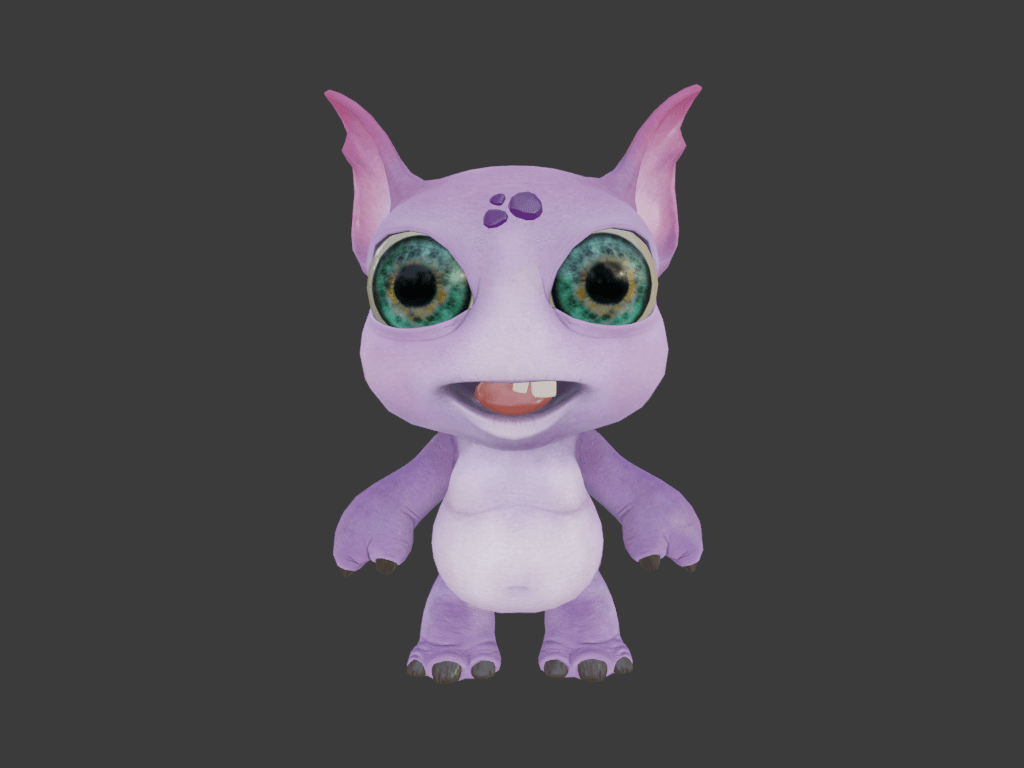
Here is where we load the glTF assets we defined in Step 7. `loadCharacter` is an asynchronous function that uses the three.js GLTFLoader to load glTF asset as three.js objects and add them to the scene. See the [three.js documentation](https://threejs.org/docs/#examples/en/loaders/GLTFLoader) for more detailed information on loading glTF assets. Once the assets are loaded, we adjust their positions and rotations so they are standing next to and slightly facing each other.
```javascript
// Find the joints defined by name
const audioAttach1 = character1.getObjectByName(audioAttachJoint1);
const audioAttach2 = character2.getObjectByName(audioAttachJoint2);
const lookTracker1 = character1.getObjectByName(lookJoint1);
const lookTracker2 = character2.getObjectByName(lookJoint2);
```
Now that the characters are loaded, we can search the character object hierarchies for the joints matching the names we defined.
```javascript
// Read the gesture config file. This file contains options for splitting up
// each animation in gestures.glb into 3 sub-animations and initializing them
// as a QueueState animation.
const gestureConfig1 = await fetch(
`${animationPath1}/${gestureConfigFile}`
).then(response => response.json());
const gestureConfig2 = await fetch(
`${animationPath2}/${gestureConfigFile}`
).then(response => response.json());
```
The `gestureConfigFile` is also being loaded here. This file is a JSON file that contains the information necessary to take each animation in `gesture.glb` and split it into 3 parts: a transition motion from the standing idle pose into the main posture of the gesture, a looping motion in the gesture posture, and a transition motion from the gesture posture back to the standing idle pose. Having a looping motion in the gesture allows us to take advantage of the `holdTime` functionality in the `GestureFeature`.
```javascript
// Read the point of interest config file. This file contains options for
// creating Blend2dStates from look pose clips and initializing look layers
// on the PointOfInterestFeature.
const poiConfig1 = await fetch(
`${animationPath1}/${poiConfigFile}`
).then(response => response.json());
const poiConfig2 = await fetch(
`${animationPath2}/${poiConfigFile}`
).then(response => response.json());
```
Finally the `poiConfigFile` gets loaded. This file has two purposes. First, it tells the `AnimationFeature` how to configure the animation states and layers associated with the animation clips imported from `poi.glb`. In addition, it tells the `PointOfInterestFeature` the information it needs to know about each animation layer it will own.
### Step 10. Initializing the Hosts
```javascript
const [
idleClips1,
lipsyncClips1,
gestureClips1,
emoteClips1,
faceClips1,
blinkClips1,
poiClips1,
] = clips1;
const host1 = createHost(
character1,
audioAttach1,
voice1,
voiceEngine,
idleClips1[0],
faceClips1[0],
lipsyncClips1,
gestureClips1,
gestureConfig1,
emoteClips1,
blinkClips1,
poiClips1,
poiConfig1,
lookTracker1,
bindPoseOffset1,
clock,
camera,
scene
);
const [
idleClips2,
lipsyncClips2,
gestureClips2,
emoteClips2,
faceClips2,
blinkClips2,
poiClips2,
] = clips2;
const host2 = createHost(
character2,
audioAttach2,
voice2,
voiceEngine,
idleClips2[0],
faceClips2[0],
lipsyncClips2,
gestureClips2,
gestureConfig2,
emoteClips2,
blinkClips2,
poiClips2,
poiConfig2,
lookTracker2,
bindPoseOffset2,
clock,
camera,
scene
);
```
Here we pass all of our assets and variables to the `createHost` function. This function is where we'll create the [HostObject](https://aws-samples.github.io/amazon-sumerian-hosts/three.js_HostObject.html) and add features to it. Next we'll inspect what makes up the `createHost` function.
- ```javascript
// Add the host to the render loop
const host = new HOST.HostObject({owner: character, clock});
renderFn.push(() => {
host.update();
});
```
We pass the character asset we loaded earlier and the three.js [clock](https://threejs.org/docs/#api/en/core/Clock) object to the `HostObject` constructor so that the host system can keep track of the asset it's manipulating and can stay in sync with the three.js clock. The clock parameter is optional but it's recommended that you pass a clock for better accuracy. This is also where we add the host's `update` function to the render loop so it will start animating.
- ```javascript
// Set up text to speech
const audioListener = new THREE.AudioListener();
camera.add(audioListener);
host.addFeature(HOST.aws.TextToSpeechFeature, false, {
listener: audioListener,
attachTo: audioAttachJoint,
voice,
engine,
});
```
Here is where we add the [TextToSpeechFeature](https://aws-samples.github.io/amazon-sumerian-hosts/TextToSpeechFeature.html) to allow the host to convert text to audio and play it back. The TextToSpeechFeature will emit messages during playback events like play/pause/resume/stop as well as when speechmarks are encountered during the audio. three.js Hosts use the three.js audio system, so we need to pass it and [AudioListener](https://threejs.org/docs/#api/en/audio/AudioListener). The host will use three.js [PositionalAudio](https://threejs.org/docs/#api/en/audio/PositionalAudio) attached to the joint in the head we found earlier when it synthesizes speech audio if we define it as the `attachTo` input parameter.
- ```javascript
// Set up animation
host.addFeature(HOST.anim.AnimationFeature);
```
Next we add the [AnimationFeature](https://aws-samples.github.io/amazon-sumerian-hosts/AnimationFeature.html). This is what allows you to manage and play animations on the host character asset. The AnimationFeature is a layered animation system, below we'll take a look at each animation layer and animations we'll add to make the host appear to speak, gesture and look at the camera.
- ```javascript
// Base idle
host.AnimationFeature.addLayer('Base');
host.AnimationFeature.addAnimation(
'Base',
idleClip.name,
HOST.anim.AnimationTypes.single,
{clip: idleClip}
);
host.AnimationFeature.playAnimation('Base', idleClip.name);
```
Here we have added a single [AnimationLayer](https://aws-samples.github.io/amazon-sumerian-hosts/AnimationLayer.html) to the host. Animation layers are containers that manage playback of a subset of animations. Each AnimationLayer can only play a single animation at any given time, but a host animation can also be a container for multiple animation assets. Here we are creating an animation of type `HOST.anim.AnimationTypes.single`, which means that the animation can only contain one three.js [AnimationClip](https://threejs.org/docs/#api/en/animation/AnimationClip). The clip we've chosen is the `stand_idle` animation, which contains looping ambient motion in a standing position. This is the animation you'll see by default when the host isn't speaking. `host.AnimationFeature.playAnimation` is telling the host to start playing the idle animation on the `Base` layer we just created.
- ```javascript
// Face idle
host.AnimationFeature.addLayer('Face', {
blendMode: HOST.anim.LayerBlendModes.Additive,
});
THREE.AnimationUtils.makeClipAdditive(faceIdleClip);
host.AnimationFeature.addAnimation(
'Face',
faceIdleClip.name,
HOST.anim.AnimationTypes.single,
{
clip: THREE.AnimationUtils.subclip(
faceIdleClip,
faceIdleClip.name,
1,
faceIdleClip.duration * 30,
30
),
}
);
host.AnimationFeature.playAnimation('Face', faceIdleClip.name);
```
The next animation layer we'll add will contain another looping idle that ambient motion in the face to help the host appear more lifelike when nothing else is going on. You'll notice that we've included an options object this time when executing [`AnimationFeature.addLayer`](https://aws-samples.github.io/amazon-sumerian-hosts/AnimationFeature.html#addLayer). `blendMode` defines the type of blending that will be used when playing animations on this layer in combination with the other layers on the host. The default is `Override`, which means that animation on the layer would cancel out animations on layers underneath, but here we have defined the layer as `Additive`. This means that the animations on this layer will add on top of the animations on the layer named `Base`. `THREE.AnimationUtils.makeClipAdditive` tells the three.js rendering engine to take the transformations of joints in the clip at frame 0 and subtract them out of the transformations on the rest of the frames. This conversion makes it possible to use the clip on an `Additive` layer without affecting the proportions of the character rig.
- ```javascript
// Blink
host.AnimationFeature.addLayer('Blink', {
blendMode: HOST.anim.LayerBlendModes.Additive,
transitionTime: 0.075,
});
blinkClips.forEach(clip => {
THREE.AnimationUtils.makeClipAdditive(clip);
});
host.AnimationFeature.addAnimation(
'Blink',
'blink',
HOST.anim.AnimationTypes.randomAnimation,
{
playInterval: 3,
subStateOptions: blinkClips.map(clip => {
return {
name: clip.name,
loopCount: 1,
clip,
};
}),
}
);
host.AnimationFeature.playAnimation('Blink', 'blink');
```
The next animation layer we'll add will contain the host's blinking behavior. It will be an `Additive` layer again, so first we'll convert the blink clips to additive format. The layer will contain a single animation with the type called [`randomAnimation`](https://aws-samples.github.io/amazon-sumerian-hosts/RandomAnimationState.html). This type of animation will periodically choose a random animation from a list of sub-animations and play it. `playInterval` defines the average number of seconds that will elapse before a new animation is chosen. This allows us to continuously trigger blink animations without manually calling play each time.
- ```javascript
// Talking idle
host.AnimationFeature.addLayer('Talk', {
transitionTime: 0.75,
blendMode: HOST.anim.LayerBlendModes.Additive,
});
host.AnimationFeature.setLayerWeight('Talk', 0);
const talkClip = lipsyncClips.find(c => c.name === 'stand_talk');
lipsyncClips.splice(lipsyncClips.indexOf(talkClip), 1);
host.AnimationFeature.addAnimation(
'Talk',
talkClip.name,
HOST.anim.AnimationTypes.single,
{clip: THREE.AnimationUtils.makeClipAdditive(talkClip)}
);
host.AnimationFeature.playAnimation('Talk', talkClip.name);
```
Next we'll add a layer with another looping idle that contains a full body motion in the standing position to simulate the type of ambient gestures people make when they talk. This time we passed in a `transitionTime` variable, which defines the default amount of time it takes to blend to a new animation on the layer. We've defined `blendMode` as `Additive` again, so the results from this layer will add on top of the results from the previous layers. [AnimationFeature.setLayerWeight](https://aws-samples.github.io/amazon-sumerian-hosts/AnimationFeature.html#setLayerWeight) tells the host that we don't want animations on this layer to have any influence by default. Layers can have weight values ranging from 0-1.
- ```javascript
// Gesture animations
host.AnimationFeature.addLayer('Gesture', {
transitionTime: 0.5,
blendMode: HOST.anim.LayerBlendModes.Additive,
});
gestureClips.forEach(clip => {
const {name} = clip;
const config = gestureConfig[name];
THREE.AnimationUtils.makeClipAdditive(clip);
if (config !== undefined) {
config.queueOptions.forEach((option, index) => {
// Create a subclip for each range in queueOptions
option.clip = THREE.AnimationUtils.subclip(
clip,
`${name}_${option.name}`,
option.from,
option.to,
30
);
});
host.AnimationFeature.addAnimation(
'Gesture',
name,
HOST.anim.AnimationTypes.queue,
config
);
} else {
host.AnimationFeature.addAnimation(
'Gesture',
name,
HOST.anim.AnimationTypes.single,
{clip}
);
}
});
```
Next we create the animations that will allow the host to perform gestures in time with ssml tags emitted from the `TextToSpeechFeature`. This is where the `gestureConfigFile` we loaded earlier becomes useful. The `gestureConfig` object is used to split each gesture into sub-clips using to and from frame ranges defined in the config. Instead of creating a `single` animation for each clip, we will use a [`queue`](https://aws-samples.github.io/amazon-sumerian-hosts/QueueState.html) type animation. This type of animation allows you to define an array of clips to be played in order. The queue will automatically advance once the currently playing clip stops.
- ```javascript
// Emote animations
host.AnimationFeature.addLayer('Emote', {
transitionTime: 0.5,
});
emoteClips.forEach(clip => {
const {name} = clip;
host.AnimationFeature.addAnimation(
'Emote',
name,
HOST.anim.AnimationTypes.single,
{clip, loopCount: 1}
);
});
```
Next we create the animations that can be used as full body and face reactions. We use an `Override` layer here because we want these reactions to replace any gesture or talking idle animations that may be in progress when these animations are triggered.
- ```javascript
// Viseme poses
host.AnimationFeature.addLayer('Viseme', {
transitionTime: 0.12,
blendMode: HOST.anim.LayerBlendModes.Additive,
});
host.AnimationFeature.setLayerWeight('Viseme', 0);
// Slice off the reference frame
const blendStateOptions = lipsyncClips.map(clip => {
THREE.AnimationUtils.makeClipAdditive(clip);
return {
name: clip.name,
clip: THREE.AnimationUtils.subclip(clip, clip.name, 1, 2, 30),
weight: 0,
};
});
host.AnimationFeature.addAnimation(
'Viseme',
'visemes',
HOST.anim.AnimationTypes.freeBlend,
{blendStateOptions}
);
host.AnimationFeature.playAnimation('Viseme', 'visemes');
```
Next we create an animation that will control the lipsync animation for the host. Lipsync is achieved by blending a series of poses that correspond to viseme speechmarks that the TextToSpeechFeature emits. See the [Polly documentation](https://docs.aws.amazon.com/polly/latest/dg/viseme.html) to find out more about the visemes that Polly generates.
You'll notice a difference here when we add the animation to the layer - we're using a different animation type called [`freeBlend`](https://aws-samples.github.io/amazon-sumerian-hosts/FreeBlendState.html). This type of animation allows you to blend between N-number of three.js [AnimationClips](https://threejs.org/docs/#api/en/animation/AnimationClip) at the same time. Each clip gets its own weight, if the cumulative weight of all of the clips in the animation container exceed 1 then they are normalized. As the host performs lipsync animation, it will manipulate these blend weights behind the scenes as viseme speechmarks are encountered to shape the host's mouth to match the sounds it is making.
We're also using `THREE.AnimationUtils.subclip` to remove frame 0 from the clips controlled by the `freeBlend` animation. This is because the initial frame of each viseme pose animation is the reference frame we used inside `loadCharacter` in order to convert the keyframes to be additive, meaning that every keyframe after 0 is relative to the pose at frame 0. We no longer need this part of the animation so it gets sliced off before sending the clip to `host.AnimationFeature.addAnimation`.
- ```javascript
// POI poses
poiConfig.forEach(config => {
host.AnimationFeature.addLayer(config.name, {
blendMode: HOST.anim.LayerBlendModes.Additive,
});
// Find each pose clip and make it additive
config.blendStateOptions.forEach(clipConfig => {
const clip = poiClips.find(clip => clip.name === clipConfig.clip);
THREE.AnimationUtils.makeClipAdditive(clip);
clipConfig.clip = THREE.AnimationUtils.subclip(
clip,
clip.name,
1,
2,
30
);
});
host.AnimationFeature.addAnimation(
config.name,
config.animation,
HOST.anim.AnimationTypes.blend2d,
{...config}
);
host.AnimationFeature.playAnimation(config.name, config.animation);
// Find and store reference objects
config.reference = character.getObjectByName(
config.reference.replace(':', '')
);
});
```
Next we create the animations that will allow the host to appear to look at/focus on a target object. This is achieved by blending a series of directional poses representing horizontal and vertical rotation in each direction. If you look back in the `poiConfigFile`, you'll notice that we have split these animations up into three categories - head, eye and eyebrow. The reason we have separated these is so that we can tell the PointOfInterestFeature to control each one at a different speed, allowing us to achieve the effect of the eyes leading the head.
We're using a different animation type here called [`blend2d`](https://aws-samples.github.io/amazon-sumerian-hosts/Blend2dState.html). This type of animation allows you to associate animation clips with X and Y blend values. As these blend values are manipulated, the animation will blend between the clips whose associated X and Y values are in the range of the current values. We have defined our X and Y thresholds for each clip to equal the horizontal and vertical angles in degrees the look joint we defined earlier is rotated relative to the reference object defined for the layer in the `poiConfigFile` during the animation.
- ```javascript
// Apply bindPoseOffset clip if it exists
if (bindPoseOffset !== undefined) {
host.AnimationFeature.addLayer('BindPoseOffset', {
blendMode: HOST.anim.LayerBlendModes.Additive,
});
host.AnimationFeature.addAnimation(
'BindPoseOffset',
bindPoseOffset.name,
HOST.anim.AnimationTypes.single,
{
clip: THREE.AnimationUtils.subclip(
bindPoseOffset,
bindPoseOffset.name,
1,
2,
30
),
}
);
host.AnimationFeature.playAnimation(
'BindPoseOffset',
bindPoseOffset.name
);
}
```
The last animation layer we'll add is optional, it is not needed for all of the provided host glTF character assets. All of the host assets in the `assets/glTF/characters/adult_male` folder share a common body skeleton, as do the assets in the `assets/glTF/characters/adult_female` folder. However each host character asset has unique facial joint placement. All of the animations in the `adult_male` folder were exported from the character skeleton in `wes.glTF`, and all of those in the `adult_female` folder were exported from the character skeleton in `fiona.glTF`. To make sharing animations within the same character classification possible, each of the other host glTF character assets include an animation clip containing 2 poses called `bindpose_offset`. The first pose in this animation keyframes the joints in the position the `wes.glTF` or `fiona.glTF` meshes were bound to their skeletons at, depending on which folder the asset is located in. The second pose keyframes the joints in the pose the character’s meshes were bound to its own skeleton at. When the clip is made additive, the first pose is subtracted out of the second one, creating an offset that can be played on top of the other animations to correct the facial joints back to the starting position unique to the character asset. The `alien` asset does not contain this animation and layer because it has its own unique set of animations.
- ```javascript
// Set up Lipsync
const visemeOptions = {
layers: [{name: 'Viseme', animation: 'visemes'}],
};
const talkingOptions = {
layers: [
{
name: 'Talk',
animation: 'stand_talk',
blendTime: 0.75,
easingFn: HOST.anim.Easing.Quadratic.InOut,
},
],
};
host.addFeature(
HOST.LipsyncFeature,
false,
visemeOptions,
talkingOptions
);
```
Next we add the [LipsyncFeature](https://aws-samples.github.io/amazon-sumerian-hosts/LipsyncFeature.html). This is the feature that listens to the TextToSpeechFeature and manipulates animations in the AnimationFeature as speechmark messages are caught from the TextToSpeechFeature. This feature will have no effect until both of the prerequisite features have been added to the host.
The `visemeOptions` object tells the LipsyncFeature that we have one layer on the AnimationFeature that contains viseme-related animations, its name is `Viseme` and the freeBlend animation that contains the viseme poses is called `viseme`. The LipsyncFeature requires that the animation defined for `visemeOptions` is of type `freeBlend`, if it is not then lipsync animation will have no effect. Each layer defined in `visemeOptions` can optionally define a `visemeMap` object that maps the names of Polly visemes to options such as the name of the corresponding animation blend weight. In the provided host objects we have named all of the viseme animations to match the Polly visemes so we don't need to provide this object. See [DefaultVisemeMap](https://aws-samples.github.io/amazon-sumerian-hosts/global.html#DefaultVisemeMap) to see the required format if you define your own `visemeMap`. As the LipsyncFeature catches viseme events from the TextToSpeechFeature, it will look for the animation blend weight name defined in the `visemeMap` that corresponds with the name of the viseme speechmark. If it finds one it will blend its weight toward 1 and then back to zero over the duration of the viseme speechmark to simulate speech.
The `talkingOptions` object tells the LipsyncFeature that we have one layer on the AnimationFeature that contains ambient talking motion, its name is `Talk` and the animation we want to play on that layer while speech audio is playing is called `stand_talk`.
When the LipsyncFeature catches play and resume speech events from the TextToSpeechFeature, it will blend the weight of any viseme or talking layers defined in `visemeOptions` and `talkingOptions` to 1 and play the animation defined for the layer. When it catches pause or stop events it will blend the weights back to 0. The `blendTime` and `easingFn` inputs define how long that transition will take and the type of blending function that will be used.
Here's a look at each of the viseme poses. There is also an additional pose called 'sil', which is just the default neutral pose.
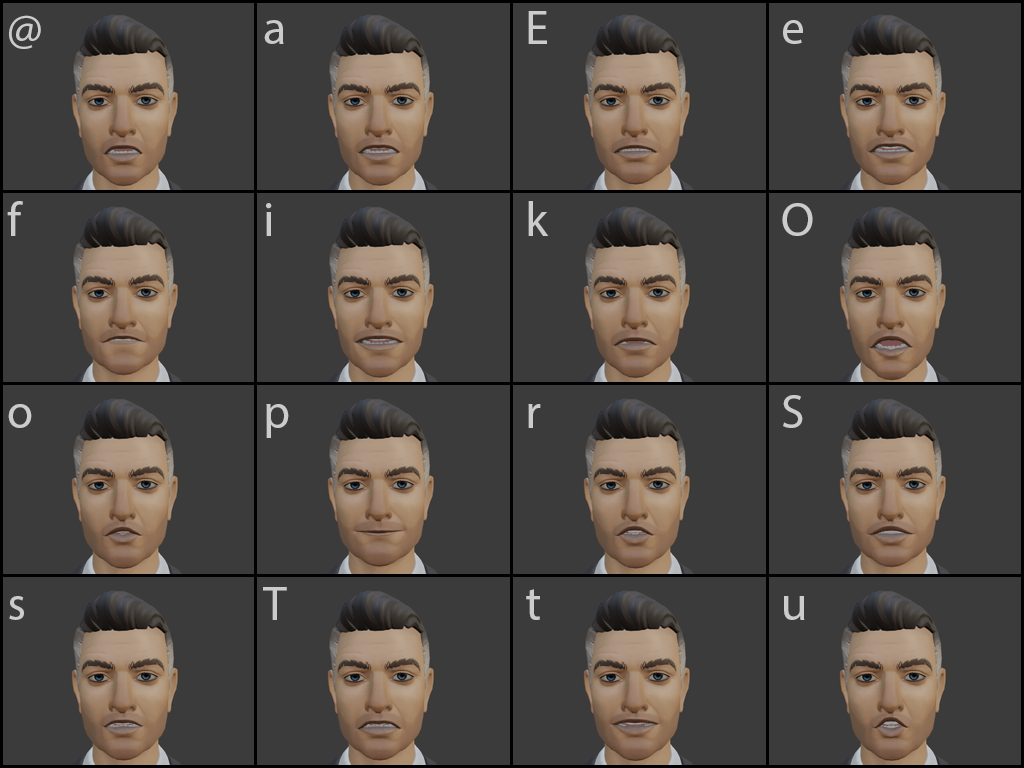
- ```javascript
// Set up Gestures
host.addFeature(HOST.GestureFeature, false, {
layers: {
Gesture: {minimumInterval: 3},
Emote: {
blendTime: 0.5,
easingFn: HOST.anim.Easing.Quadratic.InOut,
},
},
});
```
Next we add the [GestureFeature](https://aws-samples.github.io/amazon-sumerian-hosts/GestureFeature.html). This is the feature that will control the `queue` animations we created earlier, as well as the emote reaction animations. The `layer` input parameter allows you to define the names of animation layers that the feature is able to manipulate. Each layer name is associated with a gesture options object specific to that layer. The `minimumInterval` option allows you to define the minimum amount of time in seconds that must elapse after each call to [GestureFeature.playGesture](https://aws-samples.github.io/amazon-sumerian-hosts/GestureFeature.html#playGesture) before another gesture can be played. Set this option to 0 if you don't want any limitations on playing gestures. Raising this option above 0 will give better looking results when auto-generating ssml markup for gestures. Another option that can be defined is `holdTime`. Remember that we defined our gesture animations as `queue` animations, and that the second animation in each queue was set to loop infinitely. Because of this, the queue can never progress to its final animation on its own. The GestureFeature listens for when the AnimationFeature emits its `playNextAnimation` message. This message is emitted each time a `queue` animation progresses. If the GestureFeature detects that the new current animation in the queue cannot progress, it will start a timer that expires after the number of seconds defined by `holdTime` elapses. Once that happens, it will progress the queue. We'll leave it at the default value of 3 for this example.
- ```javascript
// Set up Point of Interest
host.addFeature(
HOST.PointOfInterestFeature,
false,
{
target: camera,
lookTracker: lookJoint,
scene,
},
{
layers: poiConfig,
},
{
layers: [{name: 'Blink'}],
}
);
```
Finally we add the [PointOfInterestFeature](https://aws-samples.github.io/amazon-sumerian-hosts/PointOfInterestFeature.html). This is the feature that will control the `blend2d` animations we created earlier, as well as the blink animations.
The `target` input is optional, it defines the object the host will try to look at. When no target is defined, only small saccadic movements will be periodically applied for the layers whose options have `hasSaccade` set to `true` (see `poiConfigFile`).
The `lookTracker` object is mandatory, it defines the joint in the host's skeleton that will be used to calculate the blend values necessary to make the host look at the target. This joint should be rotated by the amounts specified in the `blendThresholds` in each clip in the `blend2d` animations.
Supplying a `scene` object to the feature allows us to use the `setTargetByName` functionality to switch the target object. We've used this syntax in the default text in the textarea associated with the Luke host.
We pass in our `poiConfig` object to the look layer configuration to tell the feature which layers and animations will be driven by calculated look angles. Although it is optional, we also pass in our blink layer and animation. This allows the `PointOfInterestFeature` to trigger blink animations when the target moves a large amount over a short period of time.
**Head**
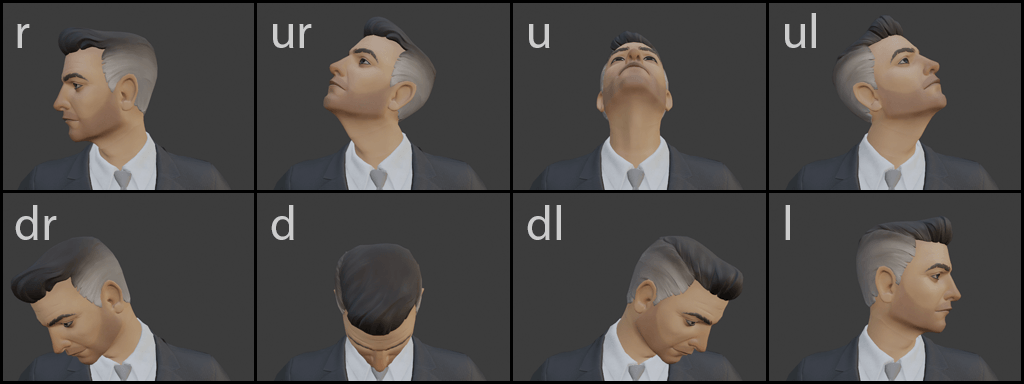
**Eyes**
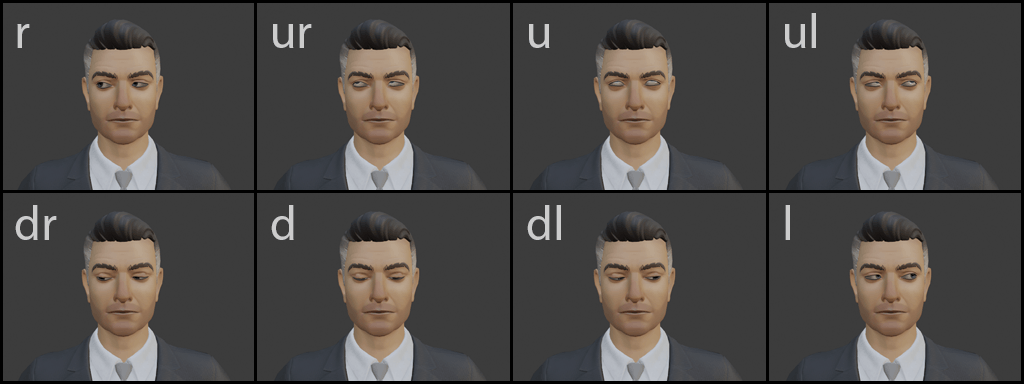
**Eyebrows**

We have now added all of the host features necessary to simulate animated speech with body gestures and object tracking. Next we'll jump back up to the main function to finish finalizing the scene.
### Step 11. Add speech listeners
```javascript
// Set up each host to look at the other when the other speaks and at the
// camera when speech ends
const onHost1StartSpeech = () => {
host2.PointOfInterestFeature.setTarget(lookTracker1);
};
const onHost2StartSpeech = () => {
host1.PointOfInterestFeature.setTarget(lookTracker2);
};
const onStopSpeech = () => {
host1.PointOfInterestFeature.setTarget(camera);
host2.PointOfInterestFeature.setTarget(camera);
};
host1.listenTo(
host1.TextToSpeechFeature.EVENTS.play,
onHost1StartSpeech
);
host1.listenTo(
host1.TextToSpeechFeature.EVENTS.resume,
onHost1StartSpeech
);
host2.listenTo(
host2.TextToSpeechFeature.EVENTS.play,
onHost2StartSpeech
);
host2.listenTo(
host2.TextToSpeechFeature.EVENTS.resume,
onHost2StartSpeech
);
HOST.aws.TextToSpeechFeature.listenTo(
HOST.aws.TextToSpeechFeature.EVENTS.pause,
onStopSpeech
);
HOST.aws.TextToSpeechFeature.listenTo(
HOST.aws.TextToSpeechFeature.EVENTS.stop,
onStopSpeech
);
```
Each time one host speaks, we'll make the other host look at them to make it appear that they are paying attention to what is being said. To do this, we will listen to the events emitted from the `TextToSpeechFeature` when speeches are played, paused, resumed and stopped. For play and resume we want to know which host started speaking so the other can look at it, so we'll listen to the host instance objects. For pause and stop we don't care which host stopped because they'll look at the camera either way, so we'll listen to the `TextToSpeechFeature` class instead. When the events are caught, we execute [PointOfInterestFeature.setTarget](https://aws-samples.github.io/amazon-sumerian-hosts/PointOfInterestFeature.html#setTarget) to change the object the host is looking at.
### Step 12. Hide the load screen
```javascript
// Hide the load screen and show the text input
document.getElementById('textToSpeech').style.display = 'inline-block';
document.getElementById('loadScreen').style.display = 'none';
```
All of the visuals for the hosts have been set up and we have begun playing back animation, so now is a good time to hide the load screen to begin showing the rendered results. We'll find and hide the loadScreen div and show the textToSpeech div.
### Step 13. Initialize the speech controls
```javascript
await speechInit;
speakers.set('Luke', host1);
speakers.set('Alien', host2);
initializeUX();
```
First we need to wait for the TextToSpeechFeature to finish being initialized. It has likely already finished at this point but we add `await speechInit` just in case the glTF assets were very quick to load.
We also need to add the host instance objects to our `speaker` object so they can be used inside `initializeUX`. We'll jump inside that function now to see how to connect those instances to the speech buttons.
```javascript
// Enable drag/drop text files on the speech text area
enableDragDrop('textEntry');
// Play, pause, resume and stop the contents of the text input as speech
// when buttons are clicked
['play', 'pause', 'resume', 'stop'].forEach(id => {
const button = document.getElementById(id);
button.onclick = () => {
const {name, host} = getCurrentHost(speakers);
const speechInput = document.getElementsByClassName(
`textEntry ${name}`
)[0];
host.TextToSpeechFeature[id](speechInput.value);
};
});
```
Our example will include [textareas](https://developer.mozilla.org/en-US/docs/Web/API/HTMLTextAreaElement) that you can use to input the text that you'd like your hosts to recite. `enableDragDrop` copies the contents of a text file into the textarea when you drag and drop a text file onto the textarea. This makes it easy to try out lots of different text.
Then we loop through our playback control buttons and add `onclick` callbacks to execute play/pause/resume/stop methods on the TextToSpeechFeature. We'll pass them the value of the textarea so that the host knows what to say. The `getCurrentHost` function will determine name and instance of the host whose methods should be called based on which tab is showing in the UX.
### Step 14. Add the ability to auto-generate SSML markup to play gestures
```javascript
// Update the text area text with gesture SSML markup when clicked
const gestureButton = document.getElementById('gestures');
gestureButton.onclick = () => {
const {name, host} = getCurrentHost(speakers);
const speechInput = document.getElementsByClassName(
`textEntry ${name}`
)[0];
const gestureMap = host.GestureFeature.createGestureMap();
const gestureArray = host.GestureFeature.createGenericGestureArray([
'Gesture',
]);
speechInput.value = HOST.aws.TextToSpeechUtils.autoGenerateSSMLMarks(
speechInput.value,
gestureMap,
gestureArray
);
};
```
[TextToSpeechUtils.autoGenerateSSMLMarks](https://aws-samples.github.io/amazon-sumerian-hosts/TextToSpeechUtils.html#autoGenerateSSMLMarks) is a method that allows you to define a speech string and an object that maps SSML mark strings to arrays of words. If words in the arrays are encountered in the speech string, an SSML mark tag is inserted with the value of the mark string prior to the word in the string and the resulting string is returned. Gestures can be triggered from mark tags by using the following syntax for the mark string: `{"feature":"GestureFeature", "method":"playGesture", "args":["", ""], {"holdTime":, "minimumInterval": {
const {host} = getCurrentHost(speakers);
host.GestureFeature.playGesture('Emote', emoteSelect.value);
};
```
We add an `onclick` callback to the `emote` button to play whichever animation name is current in the selector.
### Step 16. Initialize the host tab UX
```javascript
// Initialize tab
const tab = document.getElementsByClassName('tab current')[0];
toggleHost({target: tab});
```
Finally we will set up the functionality for updating the UX elements based on which host tab is current. We'll jump inside the `toggleHost` function to see how this works.
```javascript
const tab = evt.target;
const allTabs = document.getElementsByClassName('tab');
// Update tab classes
for (let i = 0, l = allTabs.length; i < l; i++) {
if (allTabs[i] !== tab) {
allTabs[i].classList.remove('current');
} else {
allTabs[i].classList.add('current');
}
}
// Show/hide speech input classes
const {name, host} = getCurrentHost(speakers);
const textEntries = document.getElementsByClassName('textEntry');
for (let i = 0, l = textEntries.length; i < l; i += 1) {
const textEntry = textEntries[i];
if (textEntry.classList.contains(name)) {
textEntry.classList.remove('hidden');
} else {
textEntry.classList.add('hidden');
}
}
```
When a host tab is clicked on, we need to add the `current` class to the clicked tab so we know that is the currently active host. We remove that class from the other host.
We also remove the `hidden` class from the clicked tab so that its associated textarea will be visible. We add that class to the other textarea to hide it.
```javascript
// Update emote selector
const emoteSelect = document.getElementById('emotes');
emoteSelect.length = 0;
const emotes = host.AnimationFeature.getAnimations('Emote');
emotes.forEach((emote, i) => {
const emoteOption = document.createElement('option');
emoteOption.text = emote;
emoteOption.value = emote;
emoteSelect.add(emoteOption, 0);
// Set the current item to the first emote
if (!i) {
emoteSelect.value = emote;
}
});
```
Here we will populate the empty emote selector we created earlier with the names of the animations we added to the `Emote` animation layer. [AnimationFeature.getAnimations](https://aws-samples.github.io/amazon-sumerian-hosts/AnimationFeature.html#getAnimations) returns a list of strings representing the names of animations owned by an `AnimationLayer`, we'll add each of these names as a new option in the selector.
You've now created everything necessary to load host glTF assets into the three.js rendering engine and animate them along with audio generated in Amazon Polly. The finished script (minus the Cognito Identity Pool ID) can be found in the `amazon-sumerian-hosts/examples/` directory. Run the script on a web server and give it a try. For information on how to run things locally, see the [three.js documentation](https://threejs.org/docs/#manual/en/introduction/How-to-run-things-locally).
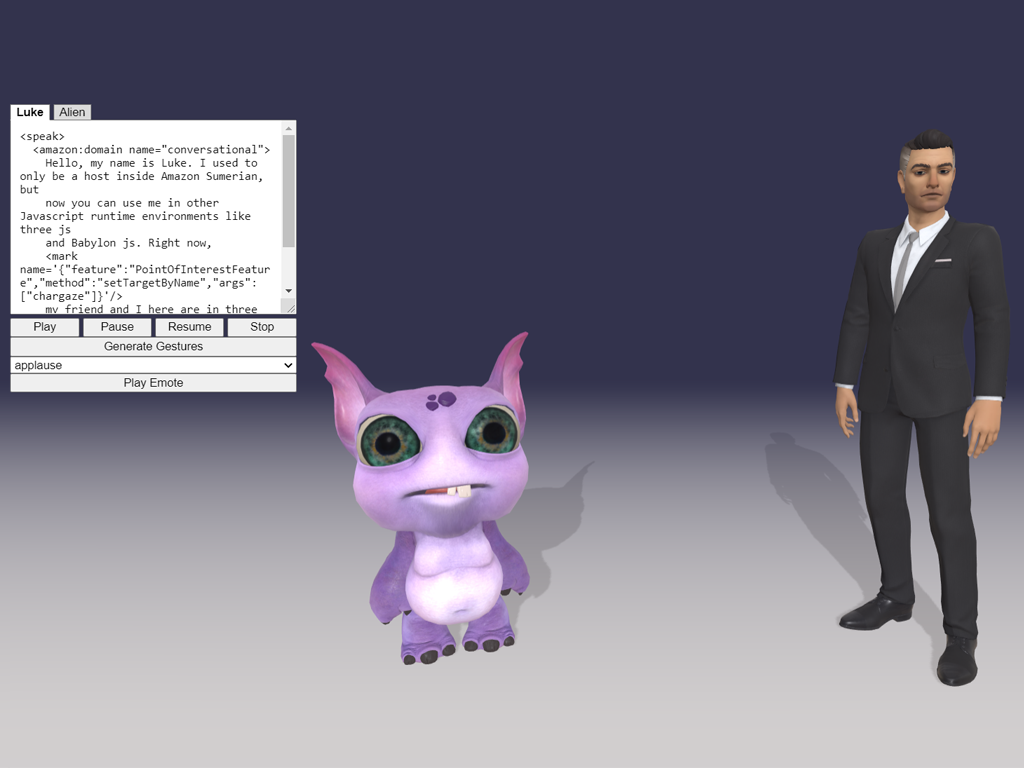
### Step 17. Next Steps
Now that you've demonstrated your hosts running locally, consider publishing them to the web via one of these related tutorials:
- [Publishing a Web Application Using AWS Amplify](https://docs.sumerian.amazonaws.com/tutorials/create/solutions/gltf-viewer-amplify-public/)
- [Privately Publish a Web Application Using AWS Amplify](https://docs.sumerian.amazonaws.com/tutorials/create/solutions/gltf-viewer-amplify-private/)